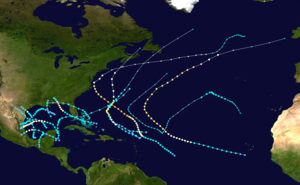| 1936 Atlantic hurricane season | |
|---|---|
 Season summary map | |
| Seasonal boundaries | |
| First system formed | June 12, 1936 |
| Last system dissipated | December 6, 1936 |
| Strongest storm | |
| Name | Thirteen |
| • Maximum winds | 120 mph (195 km/h) (1-minute sustained) |
| • Lowest pressure | 962 mbar (hPa; 28.41 inHg) |
| Seasonal statistics | |
| Total depressions | 20 |
| Total storms | 17 |
| Hurricanes | 7 |
| Major hurricanes (Cat. 3+) | 1 |
| Total fatalities | 5 total |
| Total damage | ~ $1.23 million (1936 USD) |
| Related articles | |
The 1936 Atlantic hurricane season was a fairly active season, with 20 tropical cyclones recorded, 17 of which became tropical storms. Seven storms became hurricanes, of which one became a major hurricane. In addition, the season was unusual in the fact that no storms moved across large portions of the Caribbean Sea.[1] Seven storms, including three hurricanes, struck the United States.
The season's activity was reflected with an accumulated cyclone energy (ACE) rating of 100 units,[2] slightly higher than the 1931–1943 average of 91.2.[3] ACE is a metric used to express the energy used by a tropical cyclone during its lifetime. Therefore, a storm with a longer duration will have high values of ACE. It is only calculated at six-hour increments in which specific tropical and subtropical systems are either at or above sustained wind speeds of 39 mph (63 km/h), which is the threshold for tropical storm intensity. Thus, tropical depressions are not included here.[2]
- ^ Cite error: The named reference
mwrwas invoked but never defined (see the help page). - ^ a b "Comparison of Original and Revised HURDAT". Hurricane Research Division. National Oceanic and Atmospheric Administration. September 2021. Retrieved October 4, 2021.
- ^ Christopher W. Landsea; et al. (August 15, 2014). "A Reanalysis of the 1931–43 Atlantic Hurricane Database" (PDF). Journal of Climate. 27 (16). Miami, Florida: National Oceanic and Atmospheric Administration: 6111. Bibcode:2014JCli...27.6093L. doi:10.1175/JCLI-D-13-00503.1. S2CID 1785238. Retrieved October 4, 2021.